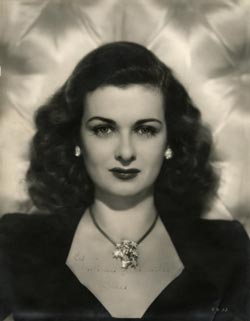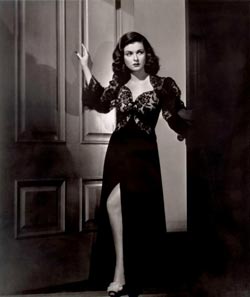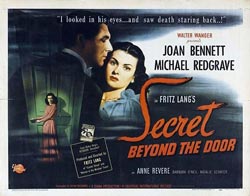 The classic femme fatale had many attributes. She was always sexy. She was usually greedy. And she was never ever to be trifled with.
The classic femme fatale had many attributes. She was always sexy. She was usually greedy. And she was never ever to be trifled with.
All of that is bound up in our basic idea of the femme fatale, the beautiful dame with death at her back. What is perhaps less readily apparent is the reality that the noir goddess is usually the smartest person in the movie. She is wised up and cynical, and the men she leads to destruction are usually a few steps behind her. A lot of noirs, after all, end with the antihero finally figuring out what the femme fatale has known all along. She holds all the answers, however terrible those answers might be.
Perhaps no one personified this quality better than Joan Bennett. Her noir bona fides are impressive. She got to the party early, playing the title role in Fritz Lang’s The Woman In The Window in 1944. That was a landmark year for the genre, the same year of Stanwyck in Double Indemnity, and Bennett was right there helping to create the archetype of the noir siren. From there she was off, issuing impressive performances in Scarlet Street, The Woman On The Beach, Secret Beyond The Door…, Hollow Triumph, The Reckless Moment, and Highway Dragnet. It’s a hell of a resume, and it would certainly place her among the great actresses of the genre.
Her real life would have made a hell of a movie—a hell of a film noir, in fact. She was raised in prestigious acting family. Her father, Richard Bennett, was a legend of the stage, a hero to Orson Welles, who cast the old man as Major Amberson in his film version of The Magnificent Ambersons. Along with her sisters Constance and Barbara, Joan was shuffled into the family business at a young age. In her early roles she was a flaxen-haired innocent, but she was already married and divorced by the age of eighteen. She knocked down another marriage in her twenties, and married producer Walter Wanger in 1940, a month shy of her thirtieth birthday.
The marriage was profitable for both. They formed the production company Diana (named after their daughter) along with Fritz Lang. A brief period of success—the most notable achievement of which was undoubtedly Scarlet Street—was followed by the crushing financial failure of Secret Beyond The Door… and the collapse of Wanger’s career.
Around this time, Bennett began an affair with her agent, Jennings Lang. What she didn’t know is that Wanger, already suspicious of his much younger wife, was having her followed by a private detective. When Wanger was informed that Bennett and Lang were spending sweaty afternoons together in a Beverly Hills apartment, he flew into a rage. On December 13, 1951, he found Bennett and Lang returning from a midday tryst, and as they were getting out of Bennett’s car, he shot Lang in the crotch with a .38.

Her real claim to fame, though, is the amazing run of noir films she made in the forties and fifties. She was the perfect femme fatale, all sex and sass, always stronger and smarter than the man she was with. The thing she never seemed to have was luck.
A Beginners Guide to Essential Joan Bennett
1. The Woman In the Window (1944): Edward G. Robinson is a middle-aged professor, bored by his wife and kids, who develops a crush on the portrait of a beautiful young woman in a gallery window. Then one night he meets the woman (Joan, of course) and she invites him back to her place. There, his night with his dream girl turns into a nightmare. A weak ending mars what is an otherwise strikingly beautiful (and deeply noir) film. The same creative team, headed by director Fritz Lang, teamed up a year later…
2. Scarlet Street (1945): Think of this as a second draft of The Woman In the Window. Robinson again plays an unhappily married man, a lonely painter who meets sexpot Bennett and develops a fatal crush. This time, though, Joan is a prostitute enthralled to her pimp (played by the king of sleaze, Dan Duryea). Together they string along the painter, stealing his art and passing it off as their own. When he finds out about this betrayal, all hell breaks loose. A complete masterpiece, one of the best of all noir films. Joan is perfect here as Kitty March, a woman who’s not all bad, just bad enough to ruin a man. The film also contains what is probably the most violent murder in cinema pre-Psycho.
3. The Woman On The Beach (1947): A noir melodrama from director Jean Renoir. Robert Ryan plays an emotionally disturbed Coast Guard Lieutenant who gets involved with a married couple played by Bennett and Charles Bickford. While this is beautifully shot, it is, nevertheless, a little long on exposition and short on fireworks. Joan’s terrific though, and delivers this classic retort to an enraged Ryan, “Go on. Say it. I’m nothing but a tramp. You just now figuring that out?”

5. Hollow Triumph (AKA The Scar) (1948): Here’s another cockamamie plot. Paul Henreid plays a gangster on the run who discovers a doctor who is his exact double. He decides to kill the guy and take his identity. First, he tries to woo the man’s girlfriend/secretary played by Joan. While Henried’s a little limp in the lead performance, the film is still fabulous. Shot by master cinematographer John Alton, Hollow Triumph is among the most beautiful movies ever photographed. The film’s crackling script by Daniel Fuchs contains what may be Bennett’s signature line. When Henried tells her, “You’re a bitter little lady” Joan growls back, “It’s a bitter little world.”
6. The Reckless Moment (1949): Another masterpiece, this one from director Max Ophüls. Based on the novel The Blank Wall by the underrated crime writer Elisabeth Sanxay Holding, The Reckless Moment tells the story of a married woman (Bennett) who tries to cover up a murder she thinks has been committed by her daughter. A far different role for Bennett, but one that builds on her world-weariness. Here she is trying desperately to hold her family, and her life, together. A brilliant film. See it, and then see the remake, 2001’s The Deep End with Tilda Swinton.
7. Highway Dragnet (1954): A man (played by Richard Conte) goes on the run when he’s accused of a murder he didn’t commit. He takes a couple of hostages (Bennett and Wanda Hendrix), but he gets more than he bargained for with Bennett. Here you have Joan once again playing the smartest, most in-the-know person in a film noir. Her sex bomb roles might be past her, but she’s still Joan—as ironic and beautiful and full of trouble as always.
Jake Hinkson, The Night Editor, is the author of Hell on Church Street.

PS:
You can get Scarlet Street, The Woman In the Window, Hollow Triumph (AKA The Scar), and Highway Dragnet on Netflix. And you should.
I remember Joan Bennett very well. I always enjoyed film noir. I sort of vaguely remeber the scandal but I was a kid then and news wasn’t the 24 hour a day thing it is now – thank God. I watched her in Dark Shadows but then it became so vampire and she disappeared. I guess that must have been her last role. I wish her storyline had continued and we had found out why her character had never left the mansion [I can’t remember its name] for so many years. But then DS became strictly vampire and there was no room for real adult characters or storylines.
Anne Christensen, we did find out why Joan Bennett’s character never left the mansion, in season 1 of Dark Shadows. Look for the video set “Dark Shadows – The Beginning”. Now available for free with an Amazon Prime subscription or free (with commercials) on Tubi.
Anne Christensen DS Joan was the star of DS and stayed on the show to the end she made two DS movies ,she made other movies and TV movies after DS
Here’s a link to a site with scans of vintage newspaper clippings related to some of Joan’s personal and professional hiccups:
http://www.collinsporthistoricalsociety.com/search?q=joan+bennett+week
I have seen all of Joan Bennett’s movies except for six early ones from 1929-1932. In terms of beauty I feel that she looked her best from Trade Winds in 1938 to Son Of Monte Cristo in 1940.My all time favorite Bennett film is The Reckless Moment in 1949, it is also my favorite movie, period. I am also extremely fond of Trade Winds, Man In The Iron Mask, House Across The Bay, Son Of Monte Cristo, Man Hunt, Twin Beds, Scarlet Street, Macomber Affair, Woman On The Beach, Secret Beyond The Door, Hollow Triumph, RecklessMoment, and The Guy Who Came Back.
As a brunette, Joan bore a resemblance to approximately a dozen famous actresses, but that was not the case when she was a blonde.There was no one else like her. I absolutely love her in Dark Shadows…